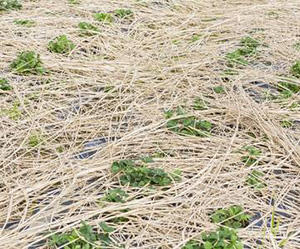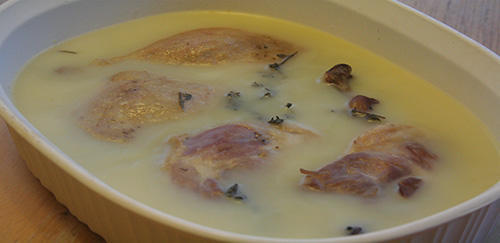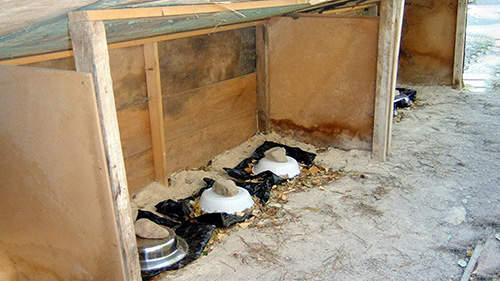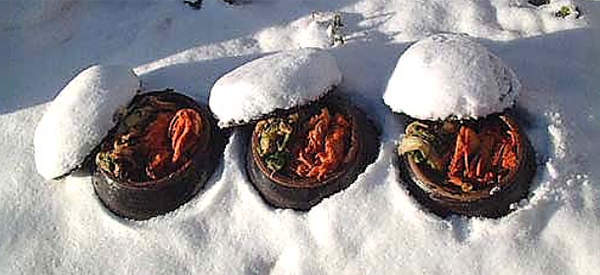Are you familiar with the term “starving spring”? How about “the hungry gap”? Well, these were two terms that represented the struggles of the average person, pre-convenience foods, to store enough food to sustain themselves and their families.
Winter would come to an end, but there would not be a crop to harvest for months yet. Animals would be sparse, and it would be a few weeks or more before anything would be ready to hunt or eat. This issue was exacerbated by the fact that spring is a time of hard work for those who settle on the land.
Spring is a time for tilling and planting. This means there is an increase in caloric needs. Without an increased calorie consumption, we are quickly faced with an issue. Thus, the above-mentioned names.
Without having adequate provisions stored you would starve to death. Such was the case in Jamestown in the winter of 1609 to 1610, where 500 settlers dwindled to a mere 60 through starvation. These survivors jumped on a ship and headed for the Chesapeake Bay where another supply ship was set to arrive.
So, what did people bury underground to try and stave off the starving spring.
Burying Grains And Vegetables
To make fresh grains and vegetables last as long as possible you will need to either bury the food and insulate it, or leave it in the ground. While the root cellar is one of the best options, it’s not something most Americans are willing to invest in anymore.
Underground Silo
A much more affordable option is the underground silo. A large enough hole is dug about three feet into the ground, and lined with bricks. The brick lining should cover the bottom and walls.
The underground silo is scaleable, so you can really make them as big or as small as you like. You can also make multiple silos that are used for different foods.
The underground silo should be topped with a sturdy lid made of stone, metal or thick wood and rope. In extreme climates you could bury the lid, as well.
When storing food in these silos you want to layer the food between dry leaves. So, you will start with a thick layer of dry leaves on the bottom, then a layer of potatoes, followed by a layer of dry leaves and another layer of potatoes.
The insulation from the lid and the leaves will protect your food through the winter.
Related: What the Pioneers Stockpiled To Survive Winter
Leave ‘Em In The Ground
 There are some foods that can benefit from being left in the ground all winter long. This is an equally old method of burying food for the winter – only you are going to leave the food buried! Forget about the shovel on this one. The only other material you will need is straw to keep some above ground plants insulated.
There are some foods that can benefit from being left in the ground all winter long. This is an equally old method of burying food for the winter – only you are going to leave the food buried! Forget about the shovel on this one. The only other material you will need is straw to keep some above ground plants insulated.
Things like carrots and garlic will over-winter in the ground no problem. In moderate to cold climates kale, Brussels and some of the hardier greens will also make it through most of the frost. If you get concerned, you can use the straw to cover them completely.
Straw should be used on the coldest nights or, if you live in a very cold area, all the time. This method will not work for things like tomatoes and peppers, but it will do fine on hardier lettuces, greens and root vegetables.
Burying Meats
Burying meat is a tricky business, but it is possible. You must be very careful about oxygen and moisture. The very best way to bury meat successfully is to utilize the animal’s fat as protection from external moisture and oxidation.
The Iroquois Method
This method of burying meat is very interesting and allows the survivor to take advantage of several parts of an animal. When you kill a deer and remove the innards, keep some of the intestines and wash them out thoroughly.
Using multiple lengths of intestine, you can cut the intestines and tie knots in one end of each. Fill the open end with raw meat, shape it into a ball and tie the end to seal it.
Next, scrape the hide for as much fat as you can get. Render it down and pour the fat over your intestine balls. Be sure you do this in a container, so you don’t lose that precious rendered fat.
Allow the fat to cool and bury the meat three feet underground. The Iroquois claimed this meat would last 100 years!
The Confit Method
Cooking food in its own fat or “confit” is a great way to create meltingly tender cuts of meat. This method is most commonly used on duck legs. The confit method was created by the French and you still find it on swanky menus today. What most people don’t realize is that, after cooking meat this way, it can be cooled and the fat that surrounds the meat will harden and protect it from the outside world. Earthenware containers, or even a good cast iron with a lid, could be buried during the winter. The fat cap or shield that protects the meat would keep it safe until temperatures rose high enough to melt it.
What most people don’t realize is that, after cooking meat this way, it can be cooled and the fat that surrounds the meat will harden and protect it from the outside world. Earthenware containers, or even a good cast iron with a lid, could be buried during the winter. The fat cap or shield that protects the meat would keep it safe until temperatures rose high enough to melt it.
Salt your meat overnight and render the fat out of your duck skin – or you can use chicken, and add something like lard to cover the meat. Cook low around 270 degrees for a few hours. Let the legs cool, and in the cold weather that fat cap will harden. Cover and bury at least three feet deep to discourage animals.
Burying Long Term Food Storage
Of course, there is also the proposition of the long-term food storage cache. While this would serve a different purpose, it could be beneficial. You would not bury your long-term food storage for preservation from the harsh cold of winter. However, you might consider burying your food storage to protect it from the other starving people around you.
You cannot give away the food you don’t have in your pantry.
Sturdy 5-gallon buckets will do just fine, and if they are outfitted with a mylar lining and an oxygen absorber you will really have something. If you decided to bury a few pails of food for reserve, or bury them at a bugout location, just be sure you do so in secret. This method is about preservation through hiding.
Related: 11 Food Storage Lessons Learned from WWI
Fermenting In The Ground
Another angle you can take when burying food through the winter is to employ fermentation. Fermentation is the magic process of food breaking down over time and becoming something new and delicious.
The most common fermented foods are things like pickles, chocolate and tea.
In Korea it’s very common to take Napa cabbage and smother it with red chili powder, fish sauce, garlic and ginger, then bury it in earthenware containers. In the ground this mixture will ferment over time and become what is known as Kimchi. Now, the interesting thing about burying kimchi is that a 6-month-old kimchi is considered young in its fermentation. I cannot think of a better food to bury and have ready for spring.
Now, the interesting thing about burying kimchi is that a 6-month-old kimchi is considered young in its fermentation. I cannot think of a better food to bury and have ready for spring.
If you are looking for something more familiar, you might consider burying sauerkraut. It is another one of those great fermenting foods that gets better with time. The beneficial bacteria will also proliferate in these foods over time.
If you are looking to bury food and preserve it through the winter, there are many methods. Deciding which route to take depends what you have grown this year and what you plan on having when the cold comes to an end.
All the methods mentioned are cheap to execute. Why not try a few different methods to see which work best for you? Now is a time of peace and excess. Now is a time for testing.
We have learned so much from the failures of the past. Let us not fall victim to the “starving time” that affected those poor settlers in Jamestown. Instead, we have the resources and the smarts to store plenty of food through the bitter winter and unearth it before our first sprouts of spring.
You may also like:
 7 Super Cheap Foods To Stockpile That People Usually Throw Away
7 Super Cheap Foods To Stockpile That People Usually Throw Away
How to Make Your House Invisible to Looters (Video)
How to Make And Can Vienna Sausages (2 Years Shelf Life)
When Grocery Stores Go Empty – A Back Door Shopping Strategy















Are the aforementioned and other methods available in print or otherwise store-able for later use?
Covering your meat in fat was written about by Julia Child (French Chief). She mentioned removing fat layers as it grew rancid because it would taint the flavor of the meat. Also has a recipe for salting meat (ham). Used this for venison when we lived off grid for 3 years. Oh yes, deer store fat in their tails as well, plus meat around the face can be cooked down with a gel that will form around the meat. Known as Head Cheese it is a common food for Latinas.
The Japanese make a pickle dish called takuan. It is made from the daikon plant. It is simple to make. Go to Wikihow.com and type “How to Make Takuan”. If you would like the recipe. Because it is a pickle dish, it last a long time. They eat it with almost every meal.
The daikon is a large radish appearing dish, although Wikihow says that it is a turnip. In Japan it grows to three feet in length and four to six inches in diameter. I have never seen it that big in U.S. markets. To me it looks like horseradish.
Great information. Thank you.
Just my opinion.
Jerry D Young
I have read that the tribal peoples in the Northwest buried whole salmon for several months allowing it to ferment, it turns into a beautiful delicious mess, or so they say. Coming to the end of their expedition Lewis and Clark stayed with a tribe that lived exclusively on salmon, the winter came to an end but the spring salmon run was late and everybody was starving. Starving spring is real and can be a big problem, game animals coming out of winter are usually in poor shape and not fit to eat, the early greens are vital then, you can’t fill up on mustard, docks, and dandelion but they are vitamin rich and a big help in recovering from the moldy bread and spoiled bacon of winter.
Don’t bury your meat pressure cook it and it will last for years. If you bury it might forget where it was buried. Lol that would be my dilemma. I wonder if those Iroquois have some stores still in the ground.
Two questions.
1) If you build your silo and line the walls and floor with brick, or use any other burial method, and you don’t fill in the cracks with mortar, how do you keep bugs out of your storage?
2) I live in a wet southern environment where we receive A LOT of rain. Not so much during the period you’re describing here, but enough. How do you water-proof your storage to keep it from filling with water? I could use plastic bags and buckets, but I assume you’re describing an historical method to use if those items aren’t available.
While I don’t have a foolproof method of draining water, you could construct what is called a french drain under the food storage pit. dig down several feet below the lowest level you want to store the food, fill most of it with pea gravel, put a layer or two of larger stone on top of the pea gravel. If your storage is on a slope, you can put in a pic weep drain under the pea gravel which will allow any accumulated water to drain out of the french drain.
I am confident there are other methods.
Sir, I remember my dad digging a hole about 2 ft deep and 3 ft wide into the side of a slope and left the front of the hole sloping downward. He then lined it with straw or hay (can’t remember) and placed turnips one deep across the straw, then covered them about several inches of straw and covered that with dirt and packed it down good. When it rained the water ran off the slope and the turnips stayed dry all winter long. When mom needed some, one of us would dig into the mound, get some, then cover it back up. It worked well. This was in NW Arkansas. Blessings to all…
I would say he probably meant to say put your items in sealed buckets and such then place them in the silo. The cool temp will help to preserve your items and the buckets will protect them from water and bugs. This is the method I use and I have had no problems.
that should read “put a pvc weep drain”. Thank you predictive. Even though I corrected predictive’s “correction” it didn’t believe that I really wanted pvc and not pic.
Well, a pic of a weep drain might also help.
The Iron Age Celts in England before the Romans arrived used to dig bell shaped silo’s for grains, minimum size was big enough for two men to fit in, to store a lot of grain.
They lined with rocks and capped with clay to be airtight. The moisture on the outside would then cause the outer grains to germinate, but without sunlight those grains would die and rot and form a crust, this process gave off carbon gas as a result and the storage silo became self sterilising.
Grains have remained identifiable for over 2000 years (but I wouldn’t eat them!) of English weather. Modern research shows storage of 50 years preservation up to 100 years highly possible, it’s unclear how long you would still edible grains in them, the 2000 year old grains that were identified were carbonised.